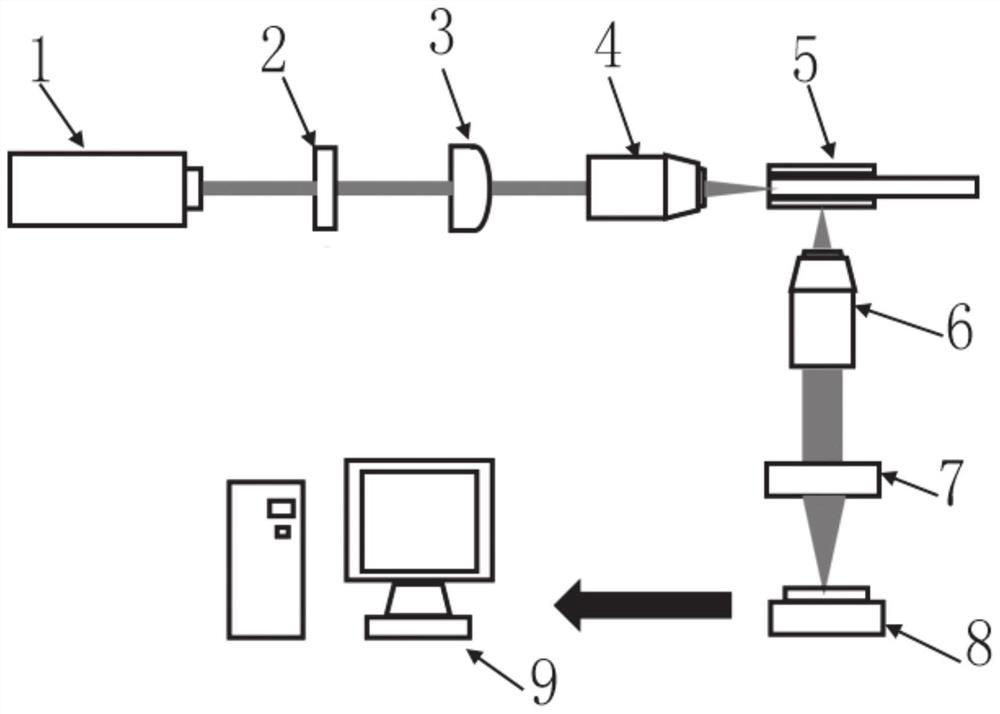Exosome particle size analysis device and method based on deep learning
A particle size analysis and deep learning technology, applied in particle size analysis, particle and sedimentation analysis, analysis of materials, etc., can solve problems such as subjectivity hindering application, avoid cross-contamination problems, avoid sample waste, and avoid the influence of stray light. Effect
- Summary
- Abstract
- Description
- Claims
- Application Information
AI Technical Summary
Problems solved by technology
Method used
Image
Examples
Embodiment 1
[0061] In this Example 1, a depth study-based exosomal particle diameter analysis device includes:
[0062] The excitation module is configured to form a laser to form an excited light to detect the sample to detect the sample.
[0063] The detection module is configured to transmit the excited light to detect the sample sample to form an exocial side direction;
[0064] Acquisition modules for obtaining video of Exose Brown movements;
[0065] The analysis module is used to combine the image, the positioning of the outer body particles, acquire the exosomal particle motion trajectory, and calculate the particle size of the particles.
[0066] The analysis module includes a positioning unit, a tracking unit, and a computing unit;
[0067] The positioning unit is configured to process the image to obtain positioning information of the image body particles by using a well-trained depth learning network, and the well-trained deep learning network is trained by training. Set of plural...
Embodiment 2
[0089] In this Example 2, a depth study-based primary particle diameter analysis apparatus and method are provided. The laser beam is formed to form a light sheet, and the exotic state particles in the solution are excited in the excitation method, and the low background noise of the outer body is used, and the video is then applied to the particle diameter analysis of the outer body. In the analysis step, first utilize a point diffusion function analog particles scattering images, and use it as a training set training depth learning network for particle positioning. After the positioning, the external secretions were tracked, and the grain size distribution of the exosomal body was obtained using Stokes Aimistan.
[0090] In this Example 2, based on deep learning of the exosomal particle diameter analysis apparatus, including the shaping of the laser, an excitation module (ie excitation module) for performing the sample chip module (detection module) detected by the outer body, F...
Embodiment 3
[0105] In this Example 3, there is provided a depth learning-based particle diameter analysis apparatus and method, using a depth learning method for particle positioning, using a dot diffusion function to simulate the particle image in a complex state, and can adapt to the noise environment. And the nanoparticle positioning in the decociated state, which has higher robustness and accuracy compared to the traditional positioning method. Light illumination excitation technology can effectively limit the excitation area, inhibit background noise, improve image signal-to-noise ratio. Homemade sample chips can be better coupled to the light-illuminated beam to further reduce the influence of stray light on the image, and the cost can be used as a disposable use module to avoid cross-contamination. The present invention can achieve particle observation of small to diameter 41 nm, satisfying the size range of the exosomass measurement and can effectively achieve measurement analysis of ...
PUM
| Property | Measurement | Unit |
|---|---|---|
| Diameter | aaaaa | aaaaa |
Abstract
Description
Claims
Application Information
 Login to View More
Login to View More - R&D
- Intellectual Property
- Life Sciences
- Materials
- Tech Scout
- Unparalleled Data Quality
- Higher Quality Content
- 60% Fewer Hallucinations
Browse by: Latest US Patents, China's latest patents, Technical Efficacy Thesaurus, Application Domain, Technology Topic, Popular Technical Reports.
© 2025 PatSnap. All rights reserved.Legal|Privacy policy|Modern Slavery Act Transparency Statement|Sitemap|About US| Contact US: help@patsnap.com



